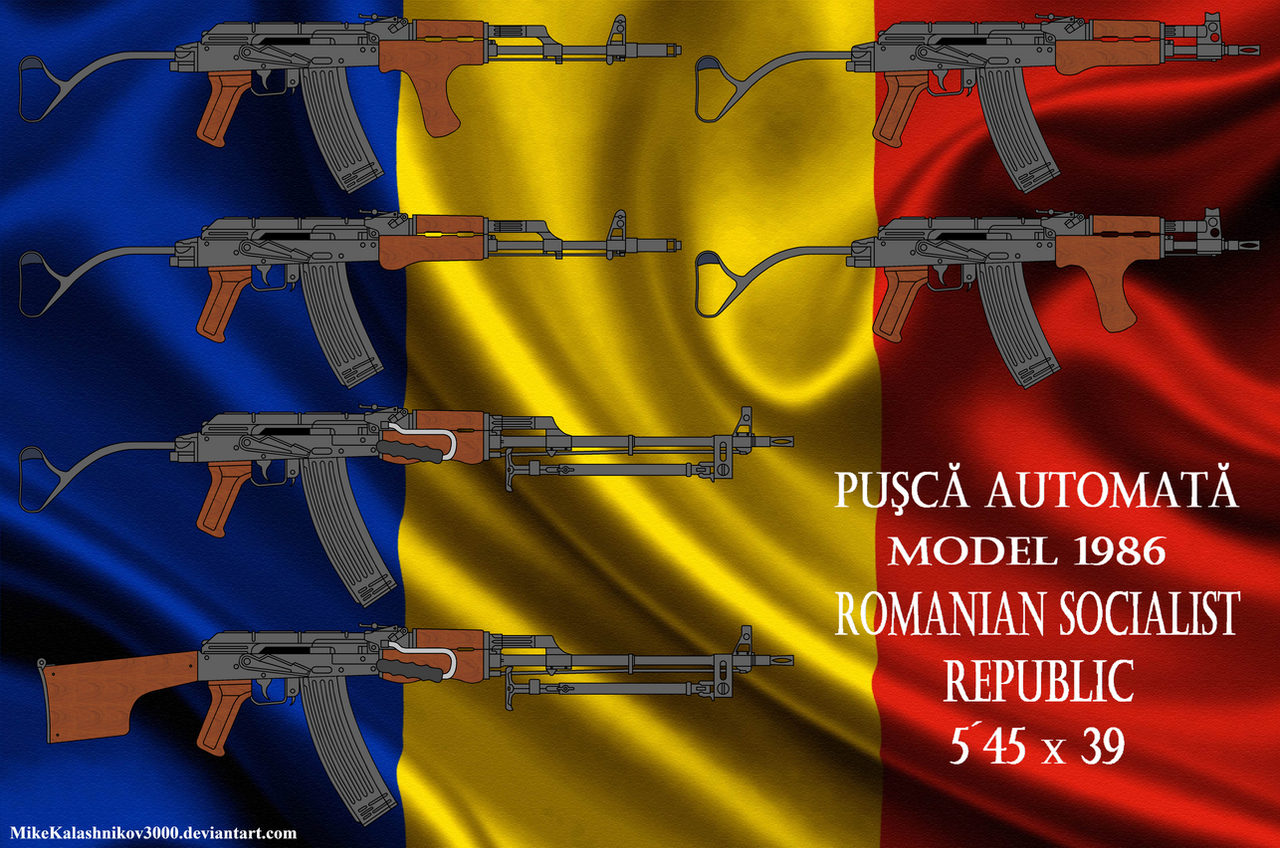HOME | DD
 MikeKalashnikov3000 — Romanian Puc Automat model 1986
MikeKalashnikov3000 — Romanian Puc Automat model 1986

#ak74 #arma #romania #war #carbines #aks74 #arma2 #afghanistanwar #romanianarmy #arma3 #russogeorgianwar #romanianarmedforces #romanianspecialforces #romanianmilitary #romanianrevolution1989 #transnistriawar #aks74u #assaultrifles #callofduty #coldwar #firearms #kalashnikov #militaryweapons #weapons #militaryhistory #rpk74 #syriancivilwar #lightmachineguns #callofdutywarzone #callofdutyblackopscoldwar
Published: 2021-05-21 20:18:27 +0000 UTC; Views: 7163; Favourites: 89; Downloads: 27
Redirect to original
Description
Hola a todos de nuevo, y aquí está otra nueva obra de Kalashnikovs Extranjeros, la cual os mostrará un fusil de asalto rumano que, quizás, no es muy famoso a nivel mundial, pero es el fusil estándar de las fuerzas armadas rumanas y deriva del fusil de asalto AK-74 soviético. Pues bien, hoy os mostraré el fusil de asalto Puşcă Automată model 1986, que quiere decir "fusil automático modelo 1986" en rumano. Ésta arma fabricada por primera vez en la antigua República Socialista de Rumanía, en el año 1986 y por la empresa armamentística RomArm S.A. tiene numerosas diferencias tanto estéticas como mecánicas en comparación con el AK-74 original, como mismo ocurre con los fusiles de asalto Zastava M70 serbios, los Kbk wz. 88 Tantal polacos, los Vz. 58 checos y los Valmet RK-62 finlandeses (que muy pronto aparecerán futuras obras dedicadas a todas estas excepcionales armas). La historia sobre su origen ocurrió de la siguiente manera: A partir de mediados de los años 70, cuando la antigua Unión Soviética comenzó a reemplazar sus fusiles AK-47 y AKM de calibre 7´62 x 39 por los nuevos fusiles AK-74 que disparan en aquel entonces novedoso cartucho 5´45 x 39, (lo más parecido en la Unión Soviética al cartucho occidental 5´56 x 45 OTAN, la munición que disparan los fusiles M16 estadounidenses y muchísimas otras armas occidentales) dicha nación incitó a los demás países comunistas del Pacto de Varsovia (firmado y establecido el 14 de mayo del año 1955) a hacer lo mismo. A mediados de los años 80, cuando Rumanía decidió adaptar sus armas a la nueva munición soviética, decidió diseñar y crear un nuevo fusil de asalto de manera totalmente independiente y que no representara una copia del AK-74 soviético. De éste modo surgió el fusil Puşcă Automată model 1986, un arma que, pese a derivar del AK-74, soviético, tiene varios elementos anacrónicos del AKM (antecesor del AK-74) que solamente pueden encontrarse en el prototipo del AK-74. La primera diferencia está en que el bloque de gas del Puşcă Automată rumano es idéntico al del AKM, pero cuya portilla de gas está colocada a 90 grados del cañón, para así minimizar el desgarro de la bala, ya que el AK-74 original tiene exactamente lo mismo, debido a problemas que mostraron los primeros fusiles AK-74 con las portillas de gas inclinadas a 45 grados. La boca del cañón del Puşcă Automată rumano puede incorporar tanto el apagallamas del AK-74 original como un apagallamas diseñado exclusivamente para las armas de las fuerzas especiales de Rumanía. el guardamanos del fusil de asalto rumano es idéntico al de su antecesor, el Pistol Mitralieră model 1963 y también incorpora su característica empuñadura vertical de madera laminada, para así aumentar la comodidad y eficacia a la hora de disparar largas ráfagas de balas en modo automático. Aunque dicha empuñadura también puede dificultar el transporte del arma por parte del usuario. El pistolete y el guardamanos inferior del Puşcă Automată rumano están hechos de madera laminada, mientras que el guardamanos superior y las cachas de su pistolete están hechos de baquelita, un plástico duro muy famoso y utilizado por su excelente imitación a la madera. El guardamanos inferior del fusil rumano puede ser reemplazado por el guardamanos del AKM o del AK-74 original (carente de su empuñadura vertical) para acoplar el lanzagranadas AG-40 y el fusil de asalto rumano incorpora una culata plegable que, aunque está montada ligeramente hacia el lado izquierdo del arma, se recoge solamente hacia el lado derecho y cuyo diseño está inspirado en las culatas plegables de los fusiles de asalto de la antigua Alemania Oriental. El fusil de asalto Puşcă Automată model 1986 no tiene versiones con culata fija, como mismo ocurre con los fusiles Type 98 norcoreanos. Los punteros láser y linternas también se pueden fijar al cañón mediante una abrazadera. A diferencia de lo que ocurre con el resto de versiones y copias extrajeras del AK-74 soviético, el Puşcă Automată model 1986 sería famoso por ser una de las pocas variantes extrajeras del AK-74 que puede disparar en modo de ráfaga corta (3 disparos). Las marcas del selector son las siguientes, de arriba a abajo: ∞, 1, 3. Solamente utiliza cargadores de acero. Los buzos de combate rumanos también utilizan fusiles Puşcă Automată model 1986 con guardamanos carentes de la empuñadura vertical, pues dicha pieza se considera demasiado incómoda para las operaciones anfibias. En cuanto a las diferencias mecánicas entre el fusil AK-74 soviético y el Puşcă Automată model 1986 rumano son las siguientes; mientras que el AK-74 soviético puede disparar entre 600 y 650 balas por minuto, el fusil Puşcă Automată model 1986 rumano dispara la increíble cifra de 700 balas por minuto. Aunque ambos fusiles de asalto disparan la misma munición, el cartucho 5´45 x 39, las balas disparadas por los fusiles AK-74 soviéticos alcanzan velocidades de entre 800 y 900 metros por segundo, mientras que las mismas balas disparadas por su versión rumana alcanzan solamente los 880 metros por segundo. Estas diferencias tanto en el diseño como en el rendimiento y las prestaciones siempre han hecho del fusil Puşcă Automată model 1986 un arma con una calidad mucho mejor que la del Ak-74 original. Por ello, los fusiles de asalto Puşcă Automată model 1986 son armas muchísimo más caras que los fusiles AK-74 soviéticos y solo están al alcance de las fuerzas armadas de Rumanía, Georgia y Afganistán. Se han visto unos pocos de éstos fusiles de asalto rumanos (así como también los fusiles AK-74M rusos y otras variantes y copias extranjeras de éstos) utilizados por las fuerzas del gobierno sirio de Bashar al-Ásad durante la Guerra Civil Siria. Espero que os guste mi nueva obra y otro cordial saludo. ¡Hasta la próxima!English translation:
Hello everyone again, and here is another new work by Kalashnikovs Foreigners, which will show you a Romanian assault rifle that, perhaps, is not very famous worldwide, but is the standard rifle of the Romanian armed forces and derives from the Soviet AK-74 assault rifle. Well, today I will show you the Puşcă Automată model 1986 assault rifle, which means "model 1986 automatic rifle" in Romanian. This weapon was manufactured for the first time in the former Socialist Republic of Romania, in 1986 and by the arms company RomArm S.A. It has numerous aesthetic and mechanical differences compared to the original AK-74, as is the case with the Serbian Zastava M70 assault rifles, the Kbk wz. 88 Polish Tantal, the Vz. 58 Czechs and the Finnish RK-62 Valmet (which will soon appear future works dedicated to all these exceptional weapons). The story of its origin occurred as follows: Beginning in the mid-1970s, when the former Soviet Union began replacing its 7'62 x 39 caliber AK-47 and AKM rifles with the new AK-74 rifles that At that time, they were firing a new 5'45 x 39 cartridge, (the closest thing in the Soviet Union to the western 5'56 x 45 NATO cartridge, the ammunition fired by the American M16 rifles and many other western weapons), that nation incited others Communist countries of the Warsaw Pact (signed and established on May 14, 1955) to do the same. In the mid-1980s, when Romania decided to adapt its weapons to the new Soviet ammunition, it decided to design and create a new assault rifle completely independently and not representing a copy of the Soviet AK-74. This is how the Puşcă Automată model 1986 rifle emerged, a weapon that, despite being derived from the Soviet AK-74, has several anachronistic elements of the AKM (predecessor of the AK-74) that can only be found in the prototype of the AK-74. The first difference is that the gas block of the Romanian Puşcă Automată is identical to that of the AKM, but whose gas hatch is placed at 90 degrees from the barrel, in order to minimize the tearing of the bullet, since the original AK-74 has Exactly the same, due to problems the first AK-74 rifles showed with the gas hatches tilted 45 degrees. The muzzle of the Romanian Puşcă Automată can incorporate both the original AK-74's flame arrester and a flame arrester designed exclusively for Romanian special forces weapons. The handguard of the Romanian assault rifle is identical to that of its predecessor, the Pistol Mitralieră model 1963 and also incorporates its characteristic vertical laminated wood handle, to increase comfort and efficiency when shooting long bursts of bullets in automatic mode. Although said handle can also hinder the transport of the weapon by the user. The Romanian Puşcă Automată pistol and pistol grip are made of laminated wood, while the upper pistol grip and grips of its pistol grip are made of Bakelite, a very famous hard plastic used for its excellent imitation of wood. The lower handguard of the Romanian rifle can be replaced by the handguard of the original AKM or AK-74 (lacking its vertical grip) to couple the AG-40 grenade launcher and the Romanian assault rifle incorporates a folding stock that, although slightly mounted towards the left side of the weapon, it is collected only towards the right side and whose design is inspired by the folding butts of the assault rifles of the former East Germany. The Puşcă Automată model 1986 assault rifle does not have versions with a fixed stock, as is the case with North Korean Type 98 rifles. Laser pointers and flashlights can also be attached to the barrel using a clamp. Unlike the rest of the versions and foreign copies of the Soviet AK-74, the 1986 Puşcă Automată model would be famous for being one of the few foreign variants of the AK-74 that can fire in short burst mode (3 shots). ). The markings on the selector are as follows, from top to bottom: ∞, 1, 3. Only uses steel chargers. Romanian combat divers also use Puşcă Automată model 1986 rifles with handguards lacking the vertical grip, as this piece is considered too cumbersome for amphibious operations. As for the mechanical differences between the Soviet AK-74 rifle and the Romanian 1986 Puşcă Automată model are the following; While the Soviet AK-74 can fire between 600 and 650 rounds per minute, the Romanian 1986 Puşcă Automată model 1986 rifle fires an incredible 700 rounds per minute. Although both assault rifles fire the same ammunition, the 5'45 x 39 cartridge, the bullets fired by the Soviet AK-74 rifles reach speeds of between 800 and 900 meters per second, while the same bullets fired by their Romanian version reach only 880 meters per second. These differences in both design and performance and performance have always made the Puşcă Automată model 1986 rifle a much better quality weapon than the original Ak-74. As a result, the 1986 Puşcă Automată model 1986 assault rifles are vastly more expensive weapons than Soviet AK-74 rifles and are only available to the armed forces of Romania, Georgia and Afghanistan. A few of these Romanian assault rifles (as well as Russian AK-74M rifles and other variants and foreign copies of them) used by Syrian government forces in Bashar al-Ásad during the Syrian Civil War have been seen. I hope you like my new work and another cordial greeting. Until next time!
Related content
Comments: 5

👍: 0 ⏩: 1

👍: 0 ⏩: 1

👍: 0 ⏩: 0

👍: 0 ⏩: 0

























